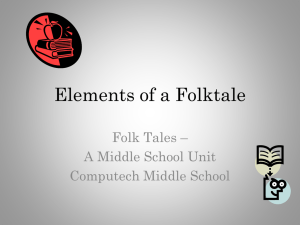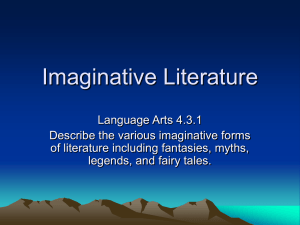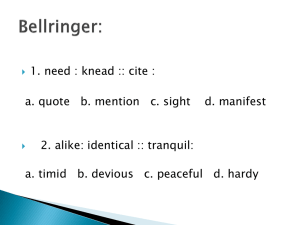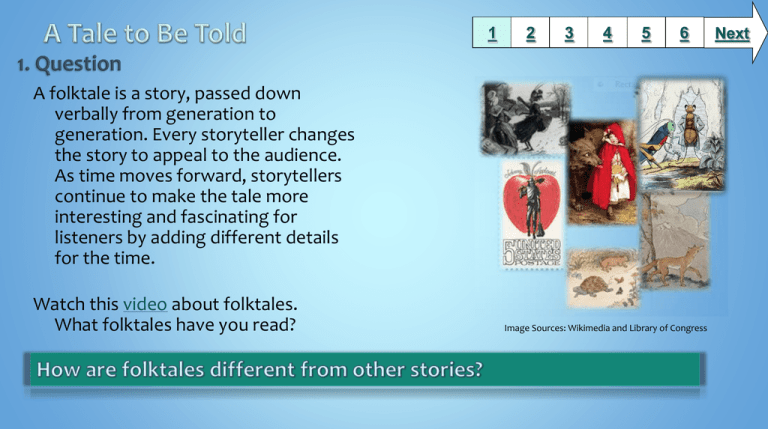
1
2
3
4
5
6
A folktale is a story, passed down
verbally from generation to
generation. Every storyteller changes
the story to appeal to the audience.
As time moves forward, storytellers
continue to make the tale more
interesting and fascinating for
listeners by adding different details
for the time.
Watch this video about folktales.
What folktales have you read?
Image Sources: Wikimedia and Library of Congress
Next
1
2
3
4
5
6
Next
You will use these resources to become a
Folktale Expert:
Introduction:
Fairy Tales, Folktales, Fables, Legends and Myths
1.
2.
3.
4.
Myths
Fairy Tales Animated Fairy Tales
Fables Aesop’s Fables Animated Fables
Legends
Image Source: www.arttoday.com by subscription
1
2
3
4
5
There are different kinds of folktales. Each
kind has a specific purpose, but they are
all told to entertain and tell us something
about a particular culture. Some
different types of folktales are Fairy tales,
Myths, Legends, Tall Tales, Fables,
Trickster Tales, and Pourquoi Tales.
Your teacher will assign you to a group and
ask you to become an expert on one kind
of folktale.
You will go to Slide 2 and use the resources
to identify elements of the folktale.
Use the inquiry organizer to take notes.
Image Source: www.arttoday.com by subscription
6
Next
1
2
3
4
5
6
You and your group will use Wixie or
PowerPoint to create a
presentation page to share your
information with the rest of the
class.
Your teacher will use this scoring
tool to assess your flipchart page.
Image Source: www.arttoday.com by subscription
Next
1
2
3
4
5
6
Next
Read, listen to and view more Fairy Tales.
Become a Folktale Fanatic.
(This is a flipchart and requires ActivInspire software. The link is to
Safari Montage for downloading.)
Write a folktale so that future generations can
learn about your culture. The folktale should
include details and a lesson that tells about a
particular culture.
Image Source: www.arttoday.com by subscription
Share your folktale with younger students so that
you can help the pass the oral tradition of
storytelling on to future generations. You can
use a digital camera or VoiceThread to record
your original folktale.
1
BCPS Curriculum
Grade 3 Library Media – Genre Study
Common Core State Standards
Reading: RL.3.2. Recount stories, including fables, folktales, and myths from diverse
cultures; determine the central message, lesson, or moral and explain how it is
conveyed through key details in the text.
Writing: 7. Conduct short as well as more sustained research projects based on focused
questions, demonstrating understanding of the subject under investigation.
Standards for the 21st Century Learner
1.1.6 Read, view, and listen for information presented in any format (e.g. textual,
visual, media, digital) in order to make inferences and gather meaning.
2.1.3 Use strategies to draw conclusions from information and apply knowledge to
curricular areas, real-world situations, and further investigations.
Maryland Technology Literacy Standards for Students
3.0: Use a variety of technologies for learning and collaboration.
2
3
4
5
6
Time Frame:
1- 50 minute class periods.
Differentiation:
Direct students to use comprehension tools included in
databases, such as: audio read-aloud, labeled reading
levels, and embedded dictionaries.
Students can work individually or in groups to complete
research.
Learning Styles:
Auditory, Visual, Reflective, Sequential, Field Independent,
Global
Notes to the teacher:
Designed for individual research instruction.
An interactive flipchart is included to reinforce and extend
the study of folktales.
Extend this research activity by having students create an
original folktale and share with younger students.
Inquiry Organizer can be printed and copied for students.
Create a display of Folktale books for students to check
out.
Last updated: July 2015
Created by Lori Horton and Diane Fontinell, Library Media Specialists
BCPS Slam Dunk Research Model, Copyright 2012, Baltimore County Public Schools, MD, all rights reserved. The models may be used for educational, non-profit school use only.
All other uses, transmissions, and duplications are prohibited unless permission is granted expressly. This lesson is based on Jamie McKenzie’s Slam Dunk Lesson module.

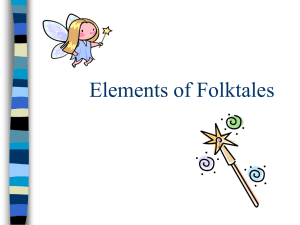
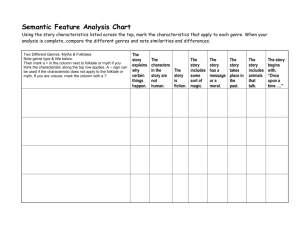
![Essay #4: [4 Short essays will substitute Essay 4]](http://s3.studylib.net/store/data/007737676_2-779981057889e025637152af438b827f-300x300.png)
